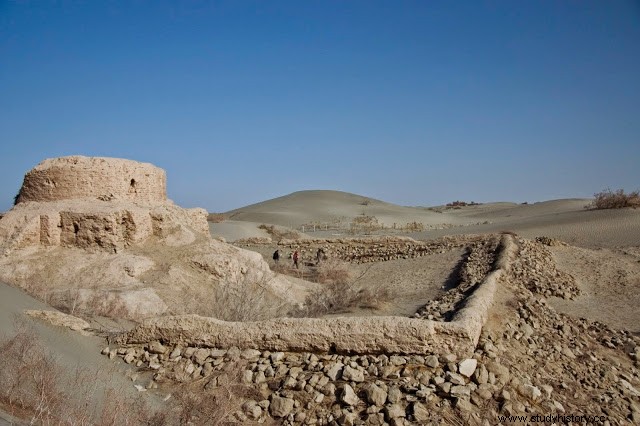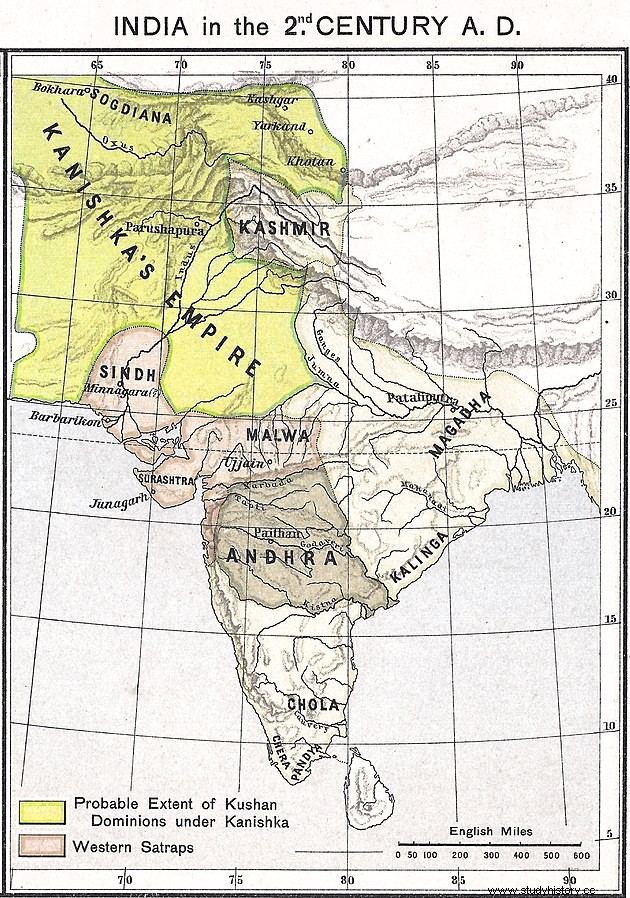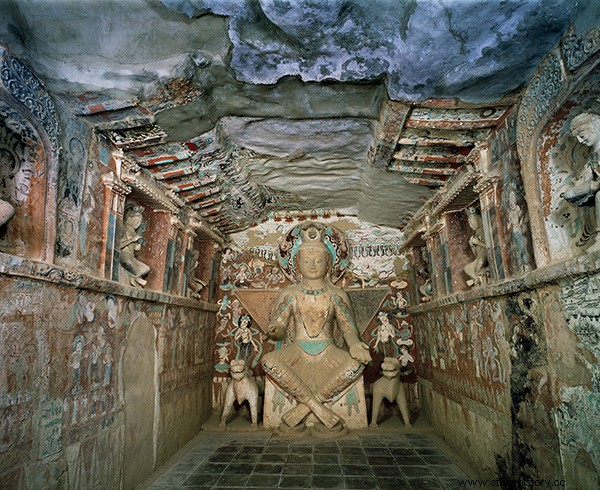The previous two articles, The Vedic History of Central Asia:From Savitri-Satyavan to the Rise of the Buddhist Kingdoms and The Vedic History of Central Asia:The Rise, Expansion and Visitation of the Buddhist Kingdoms, have proved that Central Asia was the home of India and the Indians. Not Vilayant but was part of Bharatvarsha itself. Ancient Madra, Salva kingdom and Kamboja Mahajanapada were in Central Asia only. Salva King Shalya, the maternal uncle of Savitri-Satyavan and Nakula Sahadeva, belonged to Central Asia. Some of those Hindus had adopted Buddhism in the later period and declared their states as Buddhist states. Before adopting Buddhism and being forcibly converted to Islam, the people of Central Asia were people of Aryan culture and religion.
But we Indians are no longer taught the history of this part of India. And even if they are told, they are taught as foreigners and non-Hindu and invaders in India. When we Indians who have been living here for millions of years were trying to prove the leftist, Nehruvian historians as foreigners and invaders on our own country, then the Sakas, Huns, Kushans, Pahlavas etc. called Central Asian Aryans foreigners and invaders, then wonder what That's it.
In fact, in the false history of India, written under a conspiracy under the pressure of five Muslim education ministers of the Congress, the history of all those Hindu, Buddhist states of India, which were Islamized by the Arabs and later by the Turks on the strength of the sword. It has been done so that the people of India consider this severed, torn remnant India as Bharatvarsh and remain secular, non-violent, hypertolerant and foolish as before. But if we want to ensure the unity, integrity and security of this remnant of India, then we have to deliver the true history to the people. In this part of the history of Central Asia, we are writing the history of the complete destruction of Hindu, Buddhist kingdoms of Central Asia and Middle East Asia by the Arab invaders, their Hindus, Buddhists and their religions, which is hundred percent authentic and true because this description Taken from authentic sources only.
Islamic invasion of Central Asia

After the rise of Islam in Arabia, the Arabs began attacking the Buddhist kingdoms of Sogdiana in modern-day Uzbekistan from AD 673 and conquered the kingdoms of Samarkand, Bukhara and Khorazm under the leadership of Qutaibah ibn Muslim from AD 709-712, and thus the central Asia came under Islamic caliphate.
Then the Arabs forcibly converted people here to Islam on the strength of the sword. All Hindu, Buddhist, Zoroastrian religious places were destroyed. The people here fought for decades to get rid of the Islamic invaders. The Buddhists of Bukhara became Muslims four times out of fear of Islamic terrorists and converted back to Buddhism as soon as they got the chance, but by the ninth century all the Shakas, Huns, Kushans, Greeks (Yavans) of Central Asia who originally converted Buddhists and Hindus (Aryans). righteous), were made Muslims or killed at the point of the sword. In this long period of Arab invasion and tyranny, the economy of Central Asia and Indian Hindu, Buddhist culture was completely destroyed.
Qutibah ibn Muslim, the Arabic general of Khorasan, occupied many areas of Central Asia, including Samarkand, where he destroyed the idols of many gods and goddesses. [Phillip K. Hitti, History of the Arabs, Palgrave Macmillan, p. 213]
There is evidence of the destruction of many Buddhist monasteries by Muslim invaders, but still Buddhism survived for a long time in some places. Bertolf Spuler contains several such quotations written by Narsakhi and states that the inhabitants of Bukhara converted back to Buddhism four times, despite being forcibly converted to Islam after the Qutaibah Muslim conquest in 712–13. In place of the Buddhist monastery, a mosque was built there, then some Buddhists remained there till the tenth century.
Similarly, Buddhism survived in some other places such as ancient Bukhara, Simingan in southern Turkestan, Bamiyan and Kabul where a substantial number of Indians were settled. But here it could not progress due to religious discrimination (with non-Muslims), emigration, conversion. Apart from this, Buddhism and Buddhist monasteries also came to an end due to Muslims taking over the silk trade route. [Iran in the Early Islamic Period:Politics, Culture, Administration and Public Life between the Arab and the Seljuk Conquests, 633-1055. Bertold Spuler. p. 207. ]

The Arabs conquered Balkh which was a center of Buddhism. After the conquest, they (Buddhists) were harshly insulted by the Islamic orthodoxy in Balkh. The Buddhist monastery of Nava Vihara, which had become a symbol of national resistance, was destroyed in 663 AD. The Arabs allowed non-Muslims to practice their religion as long as they paid a poll-tax called jizya. In addition to the destruction of Buddhist temples, part of the old city was also destroyed during the Arab conquest. Along with this, many other viharas were also destroyed within just a century after the Arab conquest of Central Asia. The eighth-century Korean traveler Huichao recorded some Hinayanists in Balkh under Arab rule, but the city was ruined by AD 705 as a result of frequent rebellions. (Wikipedia)
Islamic invasion of Buddhist kingdoms Khotan, Yarkand and Kashgar

Islamic invasions and conquests of Buddhist cities east of Kashgar were initiated by the Turkic karkhanid Satok Bugra Khan who converted to Islam in 966. Buddhism was defeated by Islam during the Karkhanid reign around the Kashgar region [International Dictionary of Historic Places:Asia and Oceania. Taylor &Francis. pp. 457]. Then a long war ensued between Islamic Kashgar and Buddhist Khotan, which eventually culminated in the conquest of Buddhist Khotan by the new Islamic country Kashgar.
The Shakas were the original inhabitants of Yarkand and Kashgar. They were probably of Kshatriya descent because the Shakas are mentioned in the Mahabharata as a fighting caste. Yudhishthira Saka has also been used for Yudhishthira in Indian texts and Vikramaditya's grandson Shalivahana has also been called Shalivahana Saka. Before becoming Buddhist, these Aryans were devout Hindus and kept the Indian name i.e. Hindu name. The biggest proof of the Shakas and Hunas being Aryan righteous Hindus is that the Shakas and Huns have been following the Hindu civilization culture religion since the beginning in India. Even the imperialist and leftist historians have declared Rajputs as the descendants of these Central Asian Shakas and Hunas.
Iranic Saka peoples originally inhabited Yarkand and Kashgar in ancient times. The Buddhist Saka Kingdom of Khotan was the only city-state that was not conquered yet by the Turkic Uyghur (Buddhist) and the Turkic Qarakhanid (Muslim) states and its ruling family used Indian names and the population were devout Buddhists….the Karakhanid leader Yusuf Qadir Khan conquered Khotan around 1006. [ James A. Millward (2007), Eurasian Crossroads:A History of Xinjiang. Columbia University Press. pp. 55]
The Taẕkirah is a text written by some Sufi Muslims between 1700–1849. It describes the four jihadi imams who came to aid him in the attack of Qadir Khan, probably from Iraq, against the Buddhist kingdoms of Khotan, Yarkand and Kashgar. In that book there is a gruesome description of the horrific massacre of Buddhists by Muslim invaders:
Accounts of the battles waged by the invading Muslims upon the indigenous Buddhists takes up most of the Taẕkirah with descriptions such as "blood flows like the Oxus", "heads litter the battlefield like stones" being used to describe the murderous battles over the years until the “infidels” were defeated and driven towards Khotan by Yusuf Qadir Khan and the four Imams. [Thum, Rian "Modular History:Identity Maintenance before Uyghur Nationalism" and The Journal of Asian Studies, The Association for Asian Studies. 71(3):p. 632-633]
Those four jihadi imams were killed in that war, but see the irony of Khotan, whose Hindu and Buddhist doubts they caused terrible demonic destruction, after being forcibly converted to Islam, the same Hindu, Buddhist Shaka or Khot have started worshiping them as saints. Historian Valerie Hansen writes, describing the Bughra Khan's attack on the Buddhists of Khotan:
Bughra Khan and his son directed efforts to proselytize Islam among the Turks and engage in military conquests. The Islamic conquest of Khotan led to alarm in the east and Dunhuang's Cave 17, which contained Khotanese literary works, was closed shut possibly after its caretakers heard that Khotan's Buddhist buildings were razed by the Muslims, and Khotan had suddenly ceased to be Buddhist. [ Valerie Hansen, The Silk Road:A New History. Oxford University Press. pp. 227–228]

Japanese professor Toko Moriyasu has called this war Jihad. The Karkhanid Turkic writer Mahmud al-Kashgiri has written a poem on this victory in Turkic language, whose English translation is as follows:
We came down on them like a flood,
We went out among their cities,
We tore down the idol-temples,
We shat on the Buddha's head!
He further writes, "Idols of "infidels" were subjected to desecration by being defecated upon by Muslims when the "infidel" country was conquered by the Muslims, according to Muslim tradition." [Takao Moriyasu (2004). The history of Uighur Manichaeism on the Silk Road:Research on Manichaean sources and their historical background. Otto Harrassowitz Verlag. pp. 207]
Any historians of India have the ability to write this truth? No, because lies, deceit, Muslim appeasement, anti-India mentality and political propaganda are their profession. These cannot be called historians by any standard.
Islamic invasion of Buddhist kingdom Uighur
The Buddhist kingdom Uyghur, which was in present-day China occupied Xinjiang province, where Buddhists were called Uyghur Buddhists, their kingdom Koch and Turfan was conquered by the Muslim Chagtai Khizr Khwaja through the Islamic religious war Ghazwa. [James A. Millward, Eurasian Crossroads:A History of Xinjiang. Columbia University Press. pp. 69]
After that Chagatai Khwaja attacked Kara Dell where the Buddhist kingdom was the only Buddhist kingdom of Uyghur Buddhists and by the strength of the sword made the entire population Muslim. And then look at the irony, after converting them to Muslims at the tip of the sword, they have been brainwashed into thinking that Kafir Kalmukh had built a Buddhist monastery in Turfan. Those people were always Muslims.
After being converted to Islam, the descendants of the previously Buddhist Uyghurs in Turfan failed to retain memory of their ancestral legacy and falsely believed that the "infidel Kalmuks" (Dzungars) were the ones who built Buddhist monuments in their area. [“The Encyclopaedia of Islam – Hamilton Alexander Rosskeen Gibb, Bernard Lewis, Johannes Hendrik Kramers, Charles Pellat, Joseph Schacht]
In fact, Muslims used to brainwash the children of converted Muslims and make them against the civilization, culture, religion, tradition and nation of their own ancestors. It was part of his politics. Therefore, along with erasing the complete history, historical, cultural evidence of the states that the Muslims used to rule, they used to brainwash the children so that the children of the forcibly made Muslims do not become rebellious after knowing the true history at some point. They continued to do this even further. The same work was done in Afghanistan. Then in Pakistan, Kashmir and Bangladesh and now in India also Muslims are being brainwashed in the same way.
Uyghur Buddhists of Xinjiang province are now called Uyghur Muslims, who have been imprisoned in millions in China in the name of making them human again and who have forcibly snatched the Quran from their hands, have banned prayers, beards, caps. And many mosques have been made toilets.
Description of Hindu-Buddhist kingdoms in the books of Muslim historians
The author of Futuhul Buldan-Ahmad bin Yahiya bin Jabir alias Biladuri, describing the attack on Sistan by Ibn Samurah in AD 653, wrote "On reaching Dawar, he surrounded the enemy in the mountain of Zur, where there was a famous Hindu temple " “…Their idol of Zur was of gold, and its eyes were two rubies. The zealous Musalmans cut off its hands and plucked out its eyes, and then remarked to the Marzaban how powerless was his idol…”
Describing the attack on Samarkand by Qutubiyah bin Muslim (705-715 AD), it is written, “Other authorities say that Kutaibah granted peace for 700,000 dirhams and entertainment for the Moslems for three days. The terms of surrender included also the houses of the idols (Buddhist idols) and the fire temples (Sun temples). The idols were thrown out, plundered of their ornaments and burned…”
Abu Ja'far Muhammad bin Jarir at Tabiri, the author of Tarikh-e-Tabiri, has written describing the attack of Qutaibah bin Muslim (705-715 AD) on Khorasan (Beykund),
“By the capture of Bekund (706 AD), he got immense wealth in loot which was more than what the Muslims got in his loot by conquering the whole of Khorasan. The poor merchants there were abroad for business when their country was attacked by enemies. When they returned home they found their houses looted and empty and then they gave their earnings to their wives and children to rescue them from the invaders. 150000 maskals of gold was found on melting the jewels looted from those women. Among the plundered items, a gold idol was also found, which was of 50000 muskals, whose eyes were of pearls, seeing the brilliance and beauty of which Qutaybah's eyes were astonished with admiration and astonishment. All of them were sent to the Caliph's general Hejaz with a request that the huge amount of weapons found in the loot of the palace should be allowed to be distributed among the soldiers."

He describes the attack of Qutaibah bin Muslim (705-715 AD) on Samarkand, writing that "the machine of war finally succeeded in breaching the city's defenses by Qutaibah (712 AD) and by some of his most valiant defenders, the archers of Qutaibah. were destroyed. The next day the war stopped when he promised to surrender. That request was accepted by Qutaibah and the next day a treaty was drawn up with the Prince of Samarkand under which Samarkand was to pay one million dirhams and three thousand slaves, in which it was clearly written that the slave children, Should not be old or physically disabled.
It was further written in that treaty that the ministers of their religious department would be expelled from their temples and the idols of the temples would be destroyed and burnt. साथ ही कुतैबाह को नगर के सबसे प्रमुख मन्दिर को मस्जिद बनाने कि अनुमति दी जाये.”
उसने आगे लिखा है, “…Kateibah accordingly set fire to the whole collection with his own hands; it was soon consumed to ashes, and 50,000 meskals of gold and silver, collected from the nails which had been used in the workmanship of the images.”
याकूब बिन लैथ (८७०-८७१ ईस्वी) द्वारा बल्ख और काबुल पर हमले का वर्णन करते हुए उसने लिखा है, “उसने बामियान पर अधिकार कर लिया, जहाँ वह सम्भवतः हेरात के रास्ते पहुंचा था, और फिर बाह्लीक (बल्ख) कि ओर बढ़ा जहाँ उसने नौशाद मन्दिर को नष्ट किया. बल्ख से लौटते हुए उसने काबुल पर हमला किया. पंजीर से लौटते हुए वह अवश्य हिन्दू शाही वंश की राजधानी से गुजरा होगा ताकि वहां के पवित्र मन्दिरों को लूट सके जो कि शाही वंश के शासकों के राज्याभिषेक का प्रतिष्ठित स्थान था, जो इसकी मूर्तिकला की सम्पत्ति से सम्पन्न था…”
उसने आगे लिखा है, “काबुल से लूट का कितना माल संग्रह किया गया इसकी स्पष्ट जानकारी नहीं है. त्वारीख-ए-सिस्तान के अनुसार ५० सोने कि मूर्तियाँ और चांदी मिले थे जबकि मसूदी हाथियों के बारे में लिखा है. जब बगदाद पहुंचा तो बगदाद के लोग हाथियों और मूर्तिपूजकों के भगवान को देखकर अचम्भित रह गये जिसे याकूब द्वारा खलीफा के पास भेज दिया गया और उसने बताया कि वे बहुत मूल्यवान थे.”
(साभार:StephenKnapp.com, मूल किताब Hindu Temples:What Happened to them)
